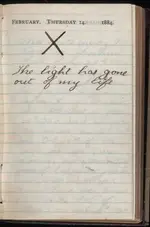L.C. I might be wrong but I think that you you may be missing Franklin's point. At the time that these caches were hidden they had no real electronic gadgets. Such as detectors, oscillators, or amplifiers. The simplest of equipment would have been available to them. Probes, compass, and shovels were the recovery tools of the day. If they needed a cache five years after they buried it they would have to go out with these crude tools and find it again. Sometimes by someone other than who buried the treasure in the first place.
It is fun to think that these gentlemen would create a complex puzzle that would take us years to unravel. The truth of the matter is or lays in human nature. We are a lazy lot and won't make anything harder than we have to. Besides out on the Iowa/Nebraska prairies you can see a great distance. Even two men working digging a hole out in the middle of nowhere would have attracted some attention. Your description is what I have heard ,seen, and read since the days of my youth. A great sea of grass. That is why the the covered wagons were call prairie schooner. Tiny ships on a sea of grass. I could see why they would use nautical measurements.
In my own families instance they were lead to a area when they went west in the 1860's by a way point called Pilot Rock. The family homestead is 11 straight north of this very rock in Cedar Township Cherokee county, Iowa. In this story is a photo of pilot rock that piloted many early settlers to the place thru a grass sea.
Cherokee Chronicle Times: Local News: Times Gone By (07/13/12) In my youth my parents would go there and us boys would crawl all over that rock and burn up or off excess energy. One of the things I remember is that on top of the rock you could see for a great ways. It might pay dividends to see if you have your own Pilot Rock some where close to your site.
Senior Deacon



 What I do know is we have to do what they told us to do to find it and not just start trying to sweep an area for map pieces or gold, there is an order to be followed and they make you smarter with every piece that is found and decoded. The G.P.R. would make me feel more confident about searching and crossing off an area in question without a doubt that we were not looking deep enough.
What I do know is we have to do what they told us to do to find it and not just start trying to sweep an area for map pieces or gold, there is an order to be followed and they make you smarter with every piece that is found and decoded. The G.P.R. would make me feel more confident about searching and crossing off an area in question without a doubt that we were not looking deep enough.
 As far as the sea measurements, Ben Ficklin, J.S.Morton, Paul Morton, and President Teddy Roosevelt all loved blockade ships or the Navy and they were all fond of the sea. Teddy actually wrote a book about ships. That anchor is on that stone to set you forth on a voyage in your ship across a sea of grass by the use of the stars and some man made objects they left behind here and there where they wouldn't stand out.
As far as the sea measurements, Ben Ficklin, J.S.Morton, Paul Morton, and President Teddy Roosevelt all loved blockade ships or the Navy and they were all fond of the sea. Teddy actually wrote a book about ships. That anchor is on that stone to set you forth on a voyage in your ship across a sea of grass by the use of the stars and some man made objects they left behind here and there where they wouldn't stand out. Coffee for MORE pondering & mulling things over...
Coffee for MORE pondering & mulling things over... 

